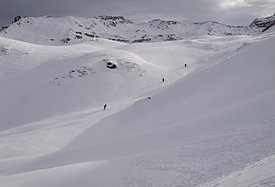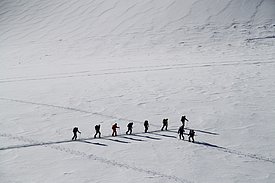Avalanches can be triggered naturally (without human influence) or by an artificially applied additional load.
Naturally triggered avalanches
When an avalanche bulletin warns of naturally triggered avalanches, these could be slab, loose-snow or gliding avalanches. The main triggers for these are, for example, the load caused by snowfall or rain, decreasing firmness of the snowpack because of warming or moistening, and a change in the slab. When an avalanche bulletin does not explicitly warn of naturally triggered avalanches, this does not mean they can be completely ruled out.
Additional load
Information given about additional load in the avalanche bulletin refers to dry slab avalanches.
- An artificial additional load is applied not only, for example, by winter sports enthusiasts and snowmobiles/groomers but also by avalanche blasting (i.e. explosions to provide protection from avalanches).
- Natural additional loads are fresh-fallen snow and rain and also collapsed cornices and ice debris. These can subject the snowpack to a very high load, thereby triggering avalanches even in fairly favourable conditions.
The definitions used by the European avalanche danger scale distinguish between 'low' and 'high' additional loads. From danger level 3 ('considerable') upwards, avalanches can even be triggered by a low additional load, whereas up to level 2 ('moderate') in general a high additional load is required.
Low additional load ¶

- Individual skiers or snowboarders making gentle turns, not falling
- Individual snowshoe hikers
- Several of the above winter sports enthusiasts with spacing between them
High additional load ¶

- A fall or a jump
- Two or more winter sports enthusiasts standing close together
- Snowmobile/groomer
- Avalanche blasting
- Collapse of a cornice, ice debris
Information on the additional load is helpful, but these are only rough guidelines which should not be accorded undue significance in the assessment. As a rule, the probability of an avalanche being triggered increases with rises in the additional load. This means that with a higher additional load there are more trigger points than with a lower one. The following aspects also need to be considered:
Size of the load
The load on the snowpack will differ depending on the individual and how he or she is moving about on the snow and on the conditions: often it will be greater on the descent than on the ascent and violent short turns or jumps will exert a greater load than big turns.
Punctual or large area
A slab avalanche can be triggered when a weak layer breaks over a sufficiently large area (initial failure). The punctual load of a pedestrian may lead to a fracture lower down in the snowpack but over a smaller area, meaning that sometimes this will not be propagated. This is particularly true when the person concerned treads deeply into the snow. Therefore, depending on the snowpack, the load of a pedestrian may be more or less dangerous than the more extensive load of a snowshoe hiker or a skier.
Spacing distances
Spacing distances are intended to avoid the loads of various individuals overlapping. As the depth increases, an additional load exerted by a person is spread over an ever larger area. This means that the additional load per unit area decreases the deeper the weak layer and the harder the snow slab, the more. This means that the additional load per unit area decreases the deeper the weak layer and the harder the snow slab, the more. For the typical depth of weak layers in skier avalanches, the area on which the additional load is large enough to initiate a fracture is usually less than one square metre. The area of influence is therefore generally limited to the immediate vicinity of the winter sport participant. As a result, the areas of influence of individual backcountry ski tourists ascending one after another do not usually overlap, and so having spaces between them only slightly reduces the probability of an avalanche release. However, as these spaces are mainly about helping to reduce the risk of multiple individuals getting buried in the snow, they are nevertheless a sensible precaution to take.
Other influences on the danger level
The danger level does not depend solely on the load required to trigger an avalanche but above all on the frequency of locations where an avalanche release is possible and the avalanche size. Where, for example, only a few areas with very weak snowpack stability are present or only small avalanches are to be expected, sometimes the danger level may still be 2 ('moderate') if only a small additional load is needed to trigger an avalanche (also see 'Small,easily triggered snowdrift accumulations' in the section 'Danger levels').